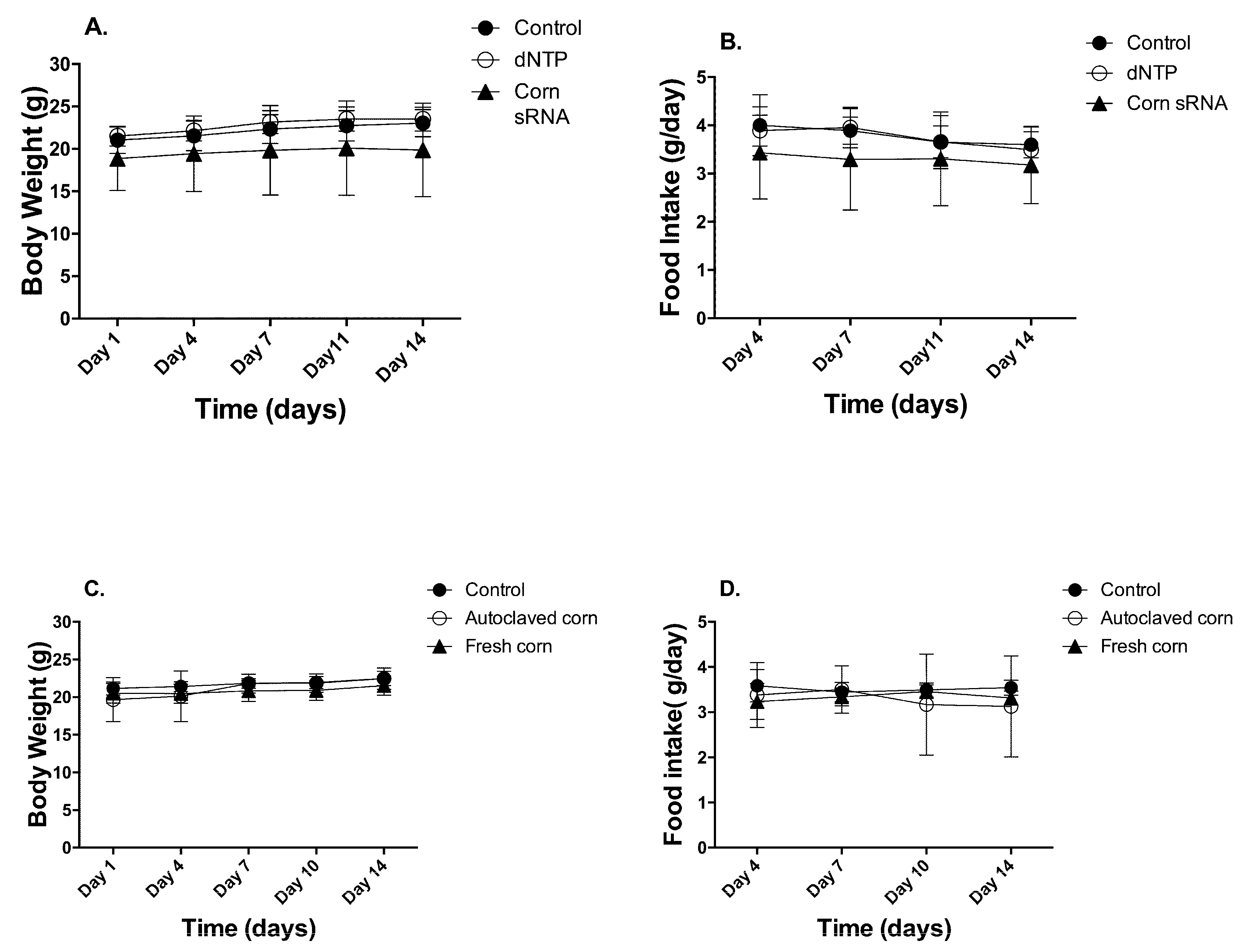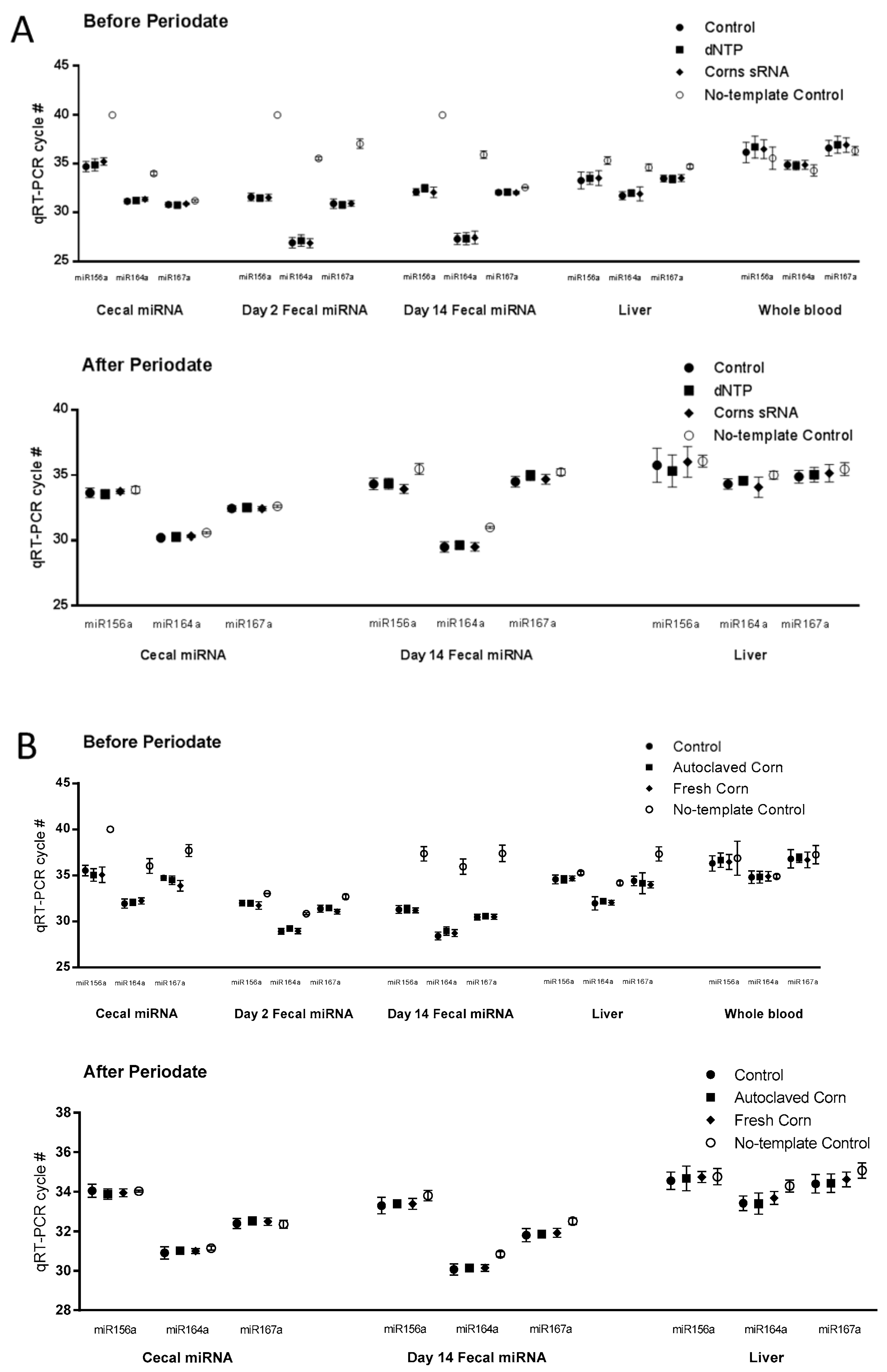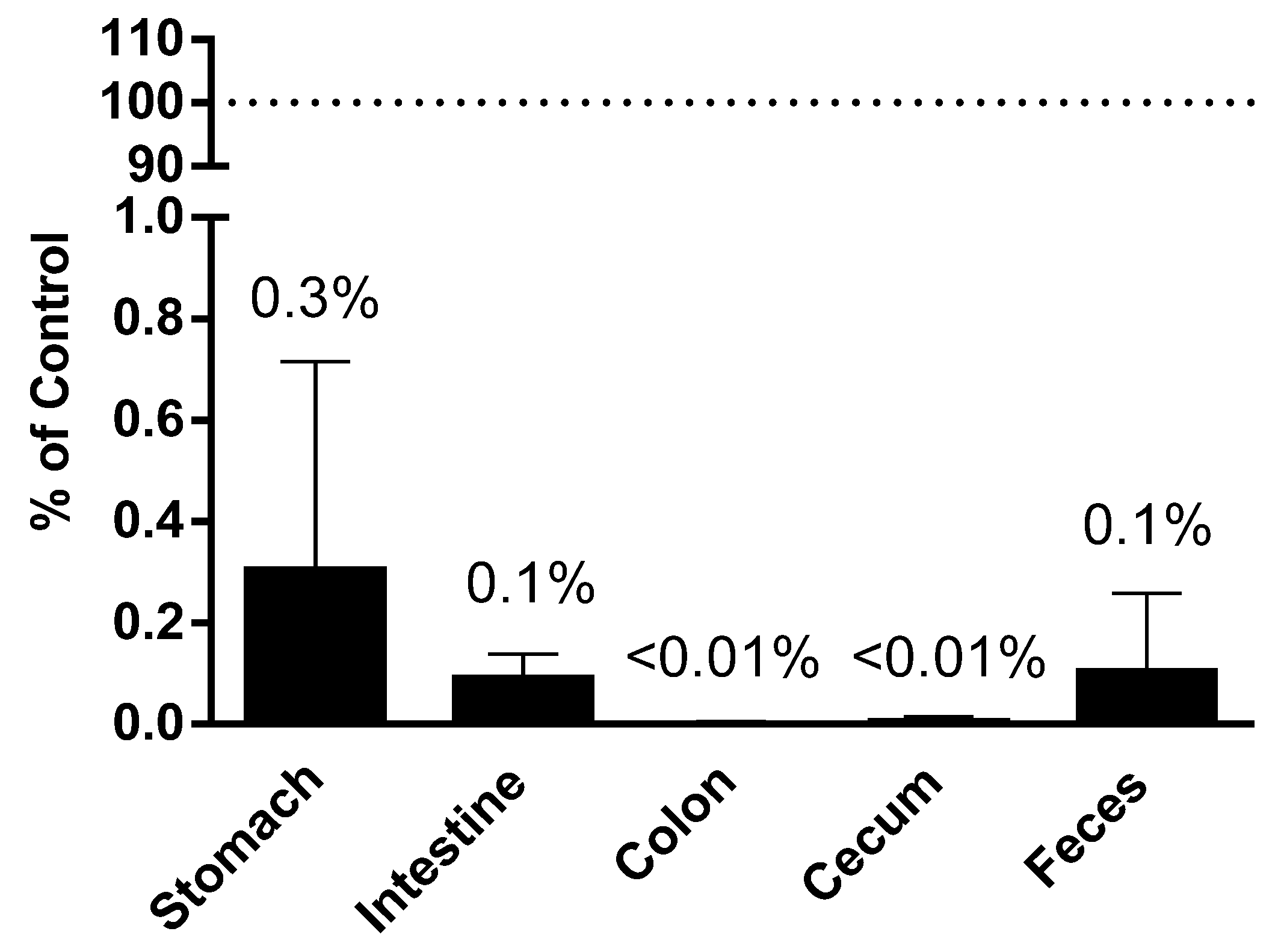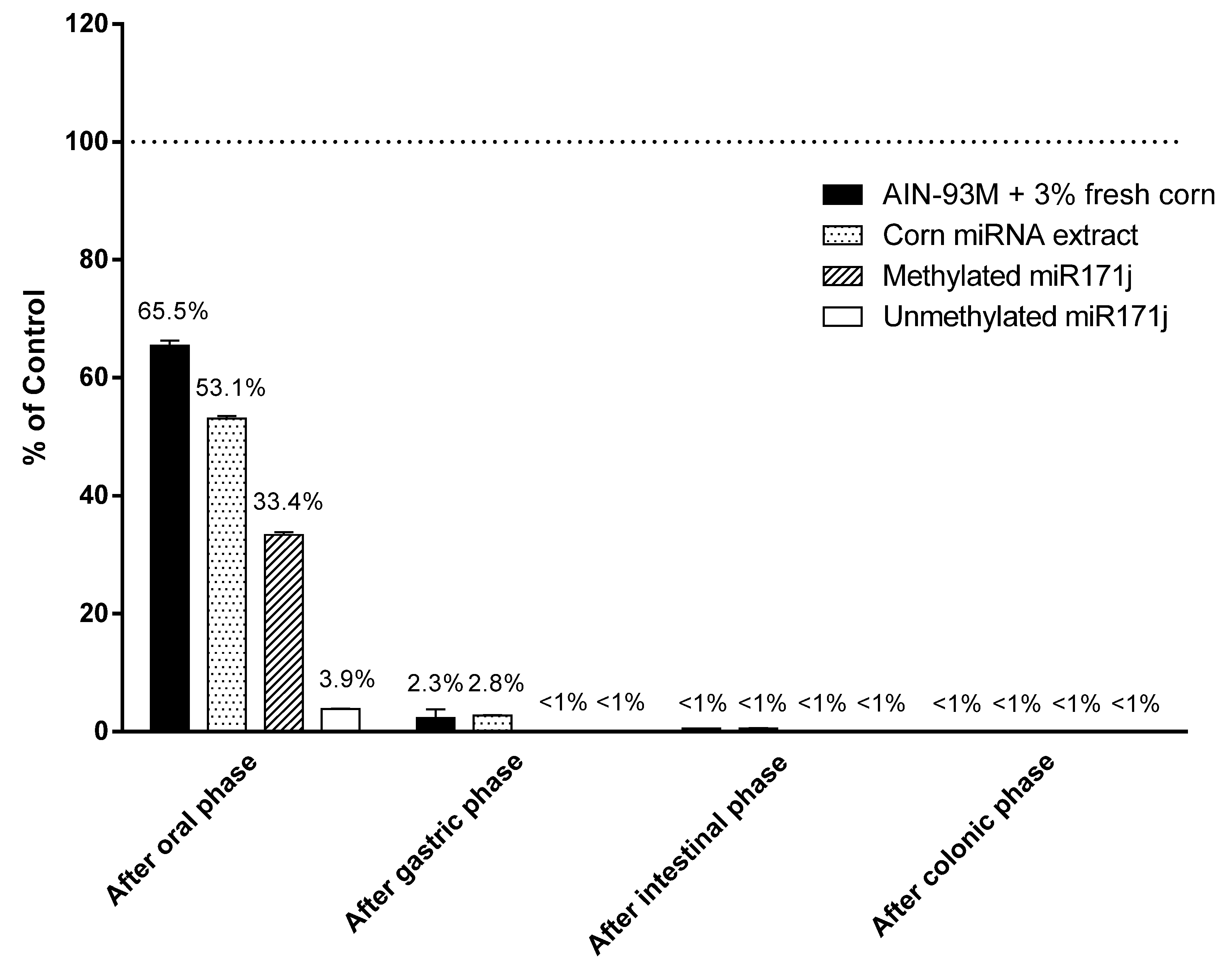Extensive Degradation and Low Bioavailability of Orally Consumed Corn miRNAs in Mice
Abstract
:1. Introduction
2. Materials and Methods
2.1. Reagents and Chemicals
2.2. Animals, Diets, and Study Design
2.3. Plant miRNA Isolation and Detection
2.4. In Vitro Digestion of Plant miRNAs
2.5. Statistical Analysis
3. Results
3.1. Food Intake, Body Weight and Levels of Corn miRNAs Consumption
3.2. Analysis of Corn miRNAs in Blood and Liver
3.3. Analysis of Corn miRNAs in Cecal and Fecal Samples
3.4. Fate of Corn miRNA in Mouse GI Tract
3.5. In Vitro Analyses of miRNA Recovery in GI Tract
4. Discussion
5. Conclusions
Supplementary Materials
Acknowledgments
Author Contributions
Conflicts of Interest
References
- Bartel, D.P. MicroRNAs: Genomics, biogenesis, mechanism, and function. Cell 2004, 116, 281–297. [Google Scholar] [CrossRef]
- He, L.; Hannon, G.J. MicroRNAs: Small RNAs with a big role in gene regulation. Nat. Rev. Genet. 2004, 5, 522–531. [Google Scholar] [CrossRef] [PubMed]
- Baer, C.; Claus, R.; Plass, C. Genome-wide epigenetic regulation of mirnas in cancer. Cancer Res. 2013, 73, 473–477. [Google Scholar] [CrossRef] [PubMed]
- Satoh, J. Molecular network analysis of human microRNA targetome: From cancers to Alzheimer’s disease. Biodata Min. 2012, 5, 22. [Google Scholar] [CrossRef] [PubMed]
- Ranjha, R.; Paul, J. Micro-RNAs in inflammatory diseases and as a link between inflammation and cancer. Inflamm. Res. 2013, 62, 343–355. [Google Scholar] [CrossRef] [PubMed]
- Zhang, L.; Hou, D.X.; Chen, X.; Li, D.H.; Zhu, L.Y.; Zhang, Y.J.; Li, J.; Bian, Z.; Liang, X.Y.; Cai, X.; et al. Exogenous plant MIR168a specifically targets mammalian LDLRAP1: Evidence of cross-kingdom regulation by microRNA. Cell Res. 2012, 22, 107–126. [Google Scholar] [CrossRef] [PubMed]
- Zhang, Y.J.; Wiggins, B.E.; Lawrence, C.; Petrick, J.; Ivashuta, S.; Heck, G. Analysis of plant-derived miRNAs in animal small RNA datasets. BMC Genomics 2012, 13. [Google Scholar] [CrossRef] [PubMed]
- Wang, K.; Li, H.; Yuan, Y.; Etheridge, A.; Zhou, Y.; Huang, D.; Wilmes, P.; Galas, D. The complex exogenous RNA spectra in human plasma: An interface with human gut biota? PLoS ONE 2012, 7, 13. [Google Scholar] [CrossRef] [PubMed]
- Beatty, M.; Guduric-Fuchs, J.; Brown, E.; Bridgett, S.; Chakravarthy, U.; Hogg, R.E.; Simpson, D.A. Small RNAs from plants, bacteria and fungi within the order hypocreales are ubiquitous in human plasma. BMC Genomics 2014, 15, 933. [Google Scholar] [CrossRef] [PubMed] [Green Version]
- Yang, J.; Farmer, L.M.; Agyekum, A.A.; Elbaz-Younes, I.; Hirschi, K.D. Detection of an abundant plant-based small RNA in healthy consumers. PLoS ONE 2015, 10, e0137516. [Google Scholar] [CrossRef] [PubMed]
- Chin, A.R.; Fong, M.Y.; Somlo, G.; Wu, J.; Swiderski, P.; Wu, X.; Wang, S.E. Cross-kingdom inhibition of breast cancer growth by plant MIR159. Cell Res. 2016, 26, 217–228. [Google Scholar] [CrossRef] [PubMed]
- Lukasik, A.; Zielenkiewicz, P. In silico identification of plant miRNAs in mammalian breast milk exosomes–a small step forward? PLoS ONE 2014, 9, e99963. [Google Scholar] [CrossRef] [PubMed]
- Snow, J.W.; Hale, A.E.; Isaacs, S.K.; Baggish, A.L.; Chan, S.Y. Ineffective delivery of diet-derived microRNAs to recipient animal organisms. RNA Biol. 2013, 10, 1107–1116. [Google Scholar] [CrossRef] [PubMed]
- Witwer, K.W.; McAlexander, M.A.; Queen, S.E.; Adams, R.J. Real-time quantitative PCR and droplet digital PCR for plant miRNAs in mammalian blood provide little evidence for general uptake of dietary mirnas limited evidence for general uptake of dietary plant xenomirs. RNA Biol. 2013, 10, 1080–1086. [Google Scholar] [CrossRef] [PubMed]
- Dickinson, B.; Zhang, Y.J.; Petrick, J.S.; Heck, G.; Ivashuta, S.; Marshall, W.S. Lack of detectable oral bioavailability of plant microRNAs after feeding in mice. Nat. Biotechnol. 2013, 31, 965–967. [Google Scholar] [CrossRef] [PubMed]
- Witwer, K.W. Contamination or artifacts may explain reports of plant miRNAs in humans. J. Nutr. Biochem. 2015, 26, 1685. [Google Scholar] [CrossRef] [PubMed]
- Yang, J.; Primo, C.; Elbaz-Younes, I.; Hirschi, K.D. Bioavailability of transgenic microRNAs in genetically modified plants. Genes Nutr. 2017, 12, 17. [Google Scholar] [CrossRef]
- Micó, V.; Martín, R.; Lasunción, M.A.; Ordovás, J.M.; Daimiel, L. Unsuccessful detection of plant microRNAs in beer, extra virgin olive oil and human plasma after an acute ingestion of extra virgin olive oil. Plant Foods Hum. Nutr. 2016, 71, 102–108. [Google Scholar] [CrossRef] [PubMed]
- Yu, B.; Yang, Z.; Li, J.; Minakhina, S.; Yang, M.; Padgett, R.W.; Steward, R.; Chen, X. Methylation as a crucial step in plant microRNA biogenesis. Science 2005, 307, 932–935. [Google Scholar] [CrossRef] [PubMed]
- Huang, H.; Roh, J.; Davis, C.D.; Wang, T.T. An improved method to quantitate mature plant microRNA in biological matrices using modified periodate treatment and inclusion of internal controls. PLoS ONE 2017, 12, e0175429. [Google Scholar] [CrossRef] [PubMed]
- Zhang, L.; Chia, J.-M.; Kumari, S.; Stein, J.C.; Liu, Z.; Narechania, A.; Maher, C.A.; Guill, K.; McMullen, M.D.; Ware, D. A genome-wide characterization of microRNA genes in maize. PLoS Genet. 2009, 5, e1000716. [Google Scholar] [CrossRef] [PubMed]
- Ray, D.K.; Mueller, N.D.; West, P.C.; Foley, J.A. Yield trends are insufficient to double global crop production by 2050. PLoS ONE 2013, 8, e66428. [Google Scholar] [CrossRef] [PubMed]
- Ranum, P.; Peña-Rosas, J.P.; Garcia-Casal, M.N. Global maize production, utilization, and consumption. Ann. N. Y. Acad. Sci. 2014, 1312, 105–112. [Google Scholar] [CrossRef] [PubMed]
- Rosas-Cardenas, F.D.; Duran-Figueroa, N.; Vielle-Calzada, J.P.; Cruz-Hernandez, A.; Marsch-Martinez, N.; de Folter, S. A simple and efficient method for isolating small RNAs from different plant species. Plant Methods 2011, 7. [Google Scholar] [CrossRef] [PubMed]
- Minekus, M.; Alminger, M.; Alvito, P.; Ballance, S.; Bohn, T.; Bourlieu, C.; Carriere, F.; Boutrou, R.; Corredig, M.; Dupont, D. A standardised static in vitro digestion method suitable for food—An international consensus. Food Funct. 2014, 5, 1113–1124. [Google Scholar] [CrossRef] [PubMed]
- Luo, Y.; Wang, P.; Wang, X.; Wang, Y.; Mu, Z.; Li, Q.; Fu, Y.; Xiao, J.; Li, G.; Ma, Y. Detection of dietetically absorbed maize-derived microRNAs in pigs. Sci. Rep. 2017, 7, 645. [Google Scholar] [CrossRef] [PubMed]
- Izumi, H.; Kosaka, N.; Shimizu, T.; Sekine, K.; Ochiya, T.; Takase, M. Bovine milk contains microRNA and messenger RNA that are stable under degradative conditions. J. Dairy Sci. 2012, 95, 4831–4841. [Google Scholar] [CrossRef] [PubMed]
- Ge, Q.; Zhou, Y.; Lu, J.; Bai, Y.; Xie, X.; Lu, Z. MiRNA in plasma exosome is stable under different storage conditions. Molecules 2014, 19, 1568–1575. [Google Scholar] [CrossRef] [PubMed]
- Philip, A.; Ferro, V.A.; Tate, R.J. Determination of the potential bioavailability of plant microRNAs using a simulated human digestion process. Mol. Nutr. Food Res. 2015, 59, 1962–1972. [Google Scholar] [CrossRef] [PubMed] [Green Version]




| Cecal Sample | ||||||||||||
| Control | dNTP ** | Corn miRNA | No-Template Control | |||||||||
| Cycle # | Calculated conc. (fM) * | Cycle # | Calculated conc. (fM) | Cycle # | Calculated conc. (fM) | Cycle # | Calculated conc. (fM) | |||||
| miR156a | 33.64 ± 0.37 | a | 0.873 | 33.54 ± 0.40 | a | 0.936 | 33.75 ± 0.17 | a | 0.809 | 33.87 ± 0.26 | a | 0.744 |
| miR164a | 30.20 ± 0.10 | c | 9.476 | 30.26 ± 0.13 | bc | 9.090 | 30.31 ± 0.10 | b | 8.780 | 30.56 ± 0.07 | a | 7.383 |
| miR167a | 32.43 ± 0.21 | a | 2.020 | 32.51 ± 0.18 | a | 1.911 | 32.42 ± 0.17 | a | 2.034 | 32.60 ± 0.09 | a | 1.795 |
| Day 14 Fecal Sample | ||||||||||||
| Control | dNTP | Corn miRNA | No-Template Control | |||||||||
| Cycle # | Calculated conc. (fM) | Cycle # | Calculated conc. (fM) | Cycle # | Calculated conc. (fM) | Cycle # | Calculated conc. (fM) | |||||
| miR156a | 34.32 ± 0.45 | b | 0.545 | 34.34 ± 0.41 | b | 0.537 | 33.94 ± 0.35 | b | 0.709 | 35.48 ± 0.42 | a | 0.244 |
| miR164a | 29.51 ± 0.40 | b | 15.287 | 29.65 ± 0.25 | b | 13.873 | 29.52 ± 0.32 | b | 15.181 | 30.98 ± 0.08 | a | 5.518 |
| miR167a | 34.50 ± 0.41 | c | 0.481 | 34.98 ± 0.39 | ab | 0.345 | 34.68 ± 0.38 | bc | 0.425 | 35.24 ± 0.25 | a | 0.288 |
| Liver | ||||||||||||
| Control | dNTP | Corn miRNA | No-Template Control | |||||||||
| Cycle # | Calculated conc. (fM) | Cycle # | Calculated conc. (fM) | Cycle # | Calculated conc. (fM) | Cycle # | Calculated conc. (fM) | |||||
| miR156a | 35.76 ± 1.31 | a | 0.201 | 35.32 ± 1.24 | a | 0.272 | 36.02 ± 1.18 | a | 0.168 | 36.08 ± 0.46 | a | 0.161 |
| miR164a | 34.32 ± 0.40 | a | 0.545 | 34.58 ± 0.33 | a | 0.455 | 34.08 ± 0.79 | a | 0.644 | 35.01 ± 0.30 | a | 0.338 |
| miR167a | 34.89 ± 0.49 | a | 0.367 | 35.03 ± 0.56 | a | 0.333 | 35.16 ± 0.66 | a | 0.304 | 35.47 ± 0.51 | a | 0.246 |
| Whole Blood | ||||||||||||
| Control | dNTP | Corn miRNA | No-Template Control | |||||||||
| Cycle # | Calculated conc. (fM) | Cycle # | Calculated conc. (fM) | Cycle # | Calculated conc. (fM) | Cycle # | Calculated conc. (fM) | |||||
| miR156a | 36.17 ± 1.05 | a | 0.151 | 36.72 ± 1.13 | a | 0.103 | 36.50 ± 0.97 | a | 0.120 | 35.58 ± 1.14 | a | 0.228 |
| miR164a | 34.89 ± 0.47 | a | 0.367 | 34.82 ± 0.43 | a | 0.385 | 34.90 ± 0.47 | a | 0.365 | 34.32 ± 0.57 | a | 0.545 |
| miR167a | 36.61 ± 0.80 | a | 0.111 | 36.96 ± 0.87 | a | 0.087 | 36.93 ± 0.75 | a | 0.089 | 36.33 ± 0.45 | a | 0.135 |
| Cecal Sample | ||||||||||||
| Control | dNTP | Corn miRNA | No-Template Control | |||||||||
| Cycle # | Calculated conc. (fM) * | Cycle # | Calculated conc. (fM) | Cycle # | Calculated conc. (fM) | Cycle # | Calculated conc. (fM) | |||||
| miR156a | 34.05 ± 0.33 | a | 0.873 | 33.88 ± 0.26 | a | 0.739 | 33.95 ± 0.20 | a | 0.704 | 34.03 ± 0.04 | a | 0.666 |
| miR164a | 30.92 ± 0.31 | b | 5.753 | 31.03 ± 0.08 | ab | 5.330 | 31.01 ± 0.12 | ab | 5.405 | 31.15 ± 0.10 | a | 4.905 |
| miR167a | 32.41 ± 0.26 | a | 2.048 | 32.54 ± 0.21 | a | 1.872 | 32.50 ± 0.19 | a | 1.924 | 32.37 ± 0.20 | a | 2.106 |
| Day 14 Fecal Sample | ||||||||||||
| Control | dNTP | Corn miRNA | No-Template Control | |||||||||
| Cycle # | Calculated conc. (fM) | Cycle # | Calculated conc. (fM) | Cycle # | Calculated conc. (fM) | Cycle # | Calculated conc. (fM) | |||||
| miR156a | 33.31 ± 0.41 | b | 1.098 | 33.40 ± 0.14 | ab | 1.031 | 33.39 ± 0.27 | ab | 1.038 | 33.80 ± 0.26 | a | 0.781 |
| miR164a | 30.07 ± 0.28 | b | 10.369 | 30.15 ± 0.18 | b | 9.810 | 30.15 ± 0.17 | b | 9.810 | 30.86 ± 0.13 | a | 5.997 |
| miR167a | 31.81 ± 0.34 | b | 3.104 | 31.87 ± 0.19 | b | 2.978 | 31.93 ± 0.23 | b | 2.856 | 32.52 ± 0.17 | a | 1.898 |
| Liver | ||||||||||||
| Control | dNTP | Corn miRNA | No-Template Control | |||||||||
| Cycle # | Calculated conc. (fM) | Cycle # | Calculated conc. (fM) | Cycle # | Calculated conc. (fM) | Cycle # | Calculated conc. (fM) | |||||
| miR156a | 34.55 ± 0.44 | a | 0.465 | 34.67 ± 0.62 | a | 0.428 | 34.75 ± 0.28 | a | 0.405 | 34.76 ± 0.41 | a | 0.402 |
| miR164a | 33.42 ± 0.36 | b | 1.017 | 33.40 ± 0.53 | b | 1.031 | 33.68 ± 0.33 | ab | 0.849 | 34.29 ± 0.30 | a | 0.556 |
| miR167a | 34.40 ± 0.47 | b | 0.516 | 34.43 ± 0.47 | b | 0.505 | 34.62 ± 0.37 | ab | 0.443 | 35.07 ± 0.39 | a | 0.324 |
| Whole Blood | ||||||||||||
| Control | dNTP | Corn miRNA | No-Template Control | |||||||||
| Cycle # | Calculated conc. (fM) | Cycle # | Calculated conc. (fM) | Cycle # | Calculated conc. (fM) | Cycle # | Calculated conc. (fM) | |||||
| miR156a | 36.30 ± 0.83 | a | 0.138 | 36.66 ± 0.78 | a | 0.108 | 36.47 ± 0.82 | a | 0.123 | 36.89 ± 1.85 | a | 0.092 |
| miR164a | 34.81 ± 0.69 | a | 0.388 | 34.81 ± 0.63 | a | 0.388 | 34.90 ± 0.52 | a | 0.365 | 34.90 ± 0.20 | a | 0.365 |
| miR167a | 36.80 ± 0.99 | a | 0.098 | 36.86 ± 0.46 | a | 0.094 | 36.69 ± 0.85 | a | 0.105 | 37.26 ± 1.00 | a | 0.071 |
| miRNA | Intake from Gavage | Detected in Fecal Sample | % Recovered |
|---|---|---|---|
| miR156a | 56.03 pg | 0.27 pg | 0.48% |
| miR164a | 13.2 pg | 0.25 pg | 1.89% |
| miR167a | 1215.63 pg | 0.39 pg | 0.03% |
| miRNA | Intake from Diet | Detected in Fecal Sample | % Recovered |
|---|---|---|---|
| miR156a | 575.56 pg | 0.31 pg | 0.05% |
| miR164a | 217.36 pg | 1.00 pg | 0.46% |
| miR167a | 1716.44 pg | 0.73 pg | 0.04% |
© 2018 by the authors. Licensee MDPI, Basel, Switzerland. This article is an open access article distributed under the terms and conditions of the Creative Commons Attribution (CC BY) license (http://creativecommons.org/licenses/by/4.0/).
Share and Cite
Huang, H.; Davis, C.D.; Wang, T.T.Y. Extensive Degradation and Low Bioavailability of Orally Consumed Corn miRNAs in Mice. Nutrients 2018, 10, 215. https://doi.org/10.3390/nu10020215
Huang H, Davis CD, Wang TTY. Extensive Degradation and Low Bioavailability of Orally Consumed Corn miRNAs in Mice. Nutrients. 2018; 10(2):215. https://doi.org/10.3390/nu10020215
Chicago/Turabian StyleHuang, Haiqiu, Cindy D. Davis, and Thomas T. Y. Wang. 2018. "Extensive Degradation and Low Bioavailability of Orally Consumed Corn miRNAs in Mice" Nutrients 10, no. 2: 215. https://doi.org/10.3390/nu10020215






